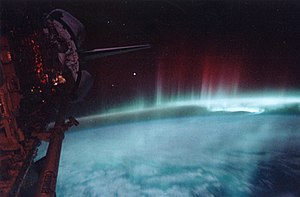
Back Orache espacial AN طقس فضائي Arabic Svemirsko vrijeme (meteorologija) BS Meteorologia espacial Catalan Vesmírné počasí Czech Rumvejr Danish Weltraumwetter German Clima espacial Spanish هواشناسی فضایی Persian Avaruussää Finnish

Space weather is a branch of space physics and aeronomy, or heliophysics, concerned with the varying conditions within the Solar System and its heliosphere. This includes the effects of the solar wind, especially on the Earth's magnetosphere, ionosphere, thermosphere, and exosphere.[1] Though physically distinct, space weather is analogous to the terrestrial weather of Earth's atmosphere (troposphere and stratosphere). The term "space weather" was first used in the 1950s and popularized in the 1990s.[2] Later, it prompted research into "space climate", the large-scale and long-term patterns of space weather.
- ^ Poppe, Barbara B.; Jorden, Kristen P. (2006). Sentinels of the Sun: Forecasting Space Weather. Johnson Books, Boulder, Colorado. ISBN 978-1-55566-379-7.
- ^ Cade III, William B.; Christina Chan-Park (2015). "The Origin of "Space Weather"". Space Weather. 13 (2): 99. Bibcode:2015SpWea..13...99C. doi:10.1002/2014SW001141.
© MMXXIII Rich X Search. We shall prevail. All rights reserved. Rich X Search